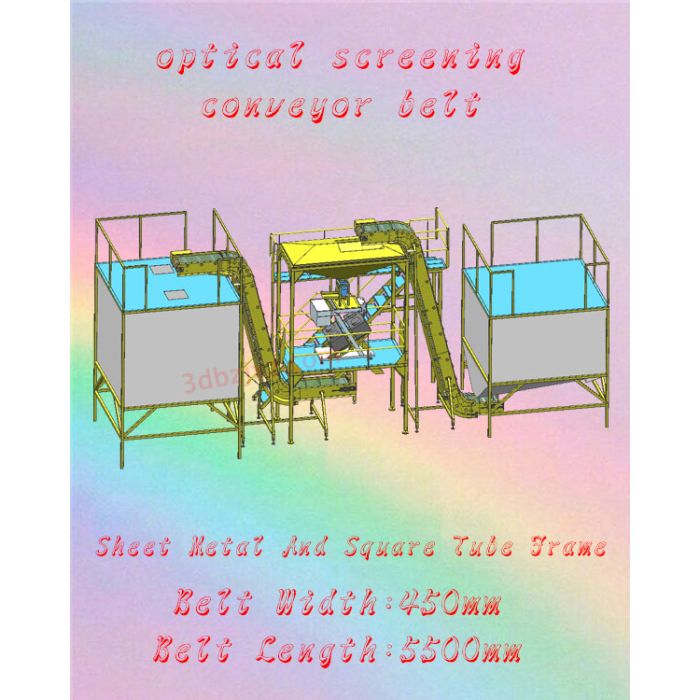beltconveyor_w450_l5500
- Stp samples download
- click to down
试用数据点击上方下载!
The principle of optical screening conveyor belt mainly involves optical principles, material identification and classification technology, and motion control of conveyor belt. The following is a detailed explanation of the principle of optical screening conveyor belt:
1、 Basic principles
Optical screening conveyor belt is a device that uses optical principles for material sorting, mainly used for the sorting and classification of granular materials. It combines optical sensors, image processing technology, and motion control of conveyor belts to achieve continuous and efficient screening of materials.
2、 Working principle
Material transportation:
The material is placed on the conveyor belt and continuously transported to the scanning area of the optical sensor through the movement of the conveyor belt.
Optical scanning and recognition:
On the conveyor belt, optical sensors continuously scan the material. These sensors typically include a combination of lenses and light sources to capture image information of materials.
Optical sensors recognize and classify materials based on their color, shape, size, and other characteristics. These feature information are transmitted through the image to the image processing system for processing and analysis.
Image processing and analysis:
The image processing system receives image information from optical sensors and processes and analyzes it.
Through image processing algorithms, the system can identify materials that do not meet the requirements, such as color deviation, shape not meeting standards, or size exceeding the range.
Material separation:
According to the analysis results of the image processing system, the control system controls the pneumatic actuator or other separation device to separate the materials that do not meet the requirements from the conveyor belt.
This is usually achieved through jet devices, robotic arms, or other automated mechanisms to ensure that only materials that meet the requirements continue to move along the conveyor belt.
3、 Key components and technologies
Optical sensors:
It is the core component of optical screening conveyor belts, responsible for capturing image information of materials.
The sensitivity and resolution of sensors directly affect the accuracy and efficiency of screening.
Image processing system:
Process and analyze image information from optical sensors to identify materials that do not meet requirements.
The image processing algorithm is the key to the system, and its accuracy and speed determine the efficiency and accuracy of screening.
Control system:
According to the analysis results of the image processing system, control the pneumatic actuator or other separation device to separate materials.
The control system also needs to ensure the stable operation and precise control of the conveyor belt.
Conveyor belt:
Responsible for transporting materials from one end to the other, ensuring that the materials can continuously and stably pass through the scanning area of the optical sensor.
The material, speed, and motion control of the conveyor belt also have a significant impact on the screening effect.
4、 Application and advantages
Optical screening conveyor belts have a wide range of applications in various fields, such as food processing, chemical industry, mining, etc. Its advantages include:
Efficient screening: capable of screening a large amount of materials in a short period of time, improving production efficiency.
High precision: Through image processing technology, materials that do not meet requirements can be accurately identified to ensure product quality.
High degree of automation: achieved automatic identification and separation of materials, reduced manual intervention, and lowered labor intensity.
Good flexibility: can be adjusted and optimized according to the characteristics of different materials to meet different screening needs.
In summary, the optical screening conveyor belt achieves continuous and efficient screening of materials by combining optical principles, material identification and classification technology, and conveyor belt motion control. Its key components include optical sensors, image processing systems, control systems, and conveyor belts. These components work together to ensure the accuracy and efficiency of screening.
光学筛选输送带的原理主要涉及光学原理、物料识别与分类技术,以及输送带的运动控制。以下是关于光学筛选输送带原理的详细解释:
一、基本原理
光学筛选输送带是一种利用光学原理进行物料分选的设备,主要应用于颗粒物料的分选和分类。它结合了光学传感器、图像处理技术和输送带的运动控制,实现了对物料的连续、高效筛选。
二、工作原理
-
物料输送:
- 物料被放置在输送带上,通过输送带的运动,物料被连续地输送到光学传感器的扫描区域。
-
光学扫描与识别:
- 在输送带上,光学传感器对物料进行连续扫描。这些传感器通常包括镜头和光源的组合,用于捕捉物料的图像信息。
- 光学传感器根据物料的颜色、形状、大小等特征进行识别和分类。这些特征信息通过图像传输到图像处理系统进行处理和分析。
-
图像处理与分析:
- 图像处理系统接收来自光学传感器的图像信息,并对其进行处理和分析。
- 通过图像处理算法,系统能够识别出不符合要求的物料,如颜色偏差、形状不符合标准或尺寸超出范围等。
-
物料分离:
- 根据图像处理系统的分析结果,控制系统控制气动执行机构或其他分离装置,将不符合要求的物料从输送带上分离出来。
- 这通常通过喷气装置、机械臂或其他自动化机构来实现,确保只有符合要求的物料继续沿输送带前进。
三、关键组件与技术
-
光学传感器:
- 是光学筛选输送带的核心组件,负责捕捉物料的图像信息。
- 传感器的灵敏度和分辨率直接影响筛选的准确性和效率。
-
图像处理系统:
- 对来自光学传感器的图像信息进行处理和分析,识别出不符合要求的物料。
- 图像处理算法是系统的关键,其准确性和速度决定了筛选的效率和准确性。
-
控制系统:
- 根据图像处理系统的分析结果,控制气动执行机构或其他分离装置进行物料分离。
- 控制系统还需要确保输送带的稳定运行和精确控制。
-
输送带:
- 负责将物料从一端输送到另一端,确保物料能够连续、稳定地通过光学传感器的扫描区域。
- 输送带的材质、速度和运动控制对筛选效果也有重要影响。
四、应用与优势
光学筛选输送带在多个领域有着广泛的应用,如食品加工、化工、矿业等。其优势包括:
- 高效筛选:能够在短时间内对大量物料进行筛选,提高生产效率。
- 高精度:通过图像处理技术,能够准确识别出不符合要求的物料,确保产品质量。
- 自动化程度高:实现了物料的自动识别和分离,减少了人工干预,降低了劳动强度。
- 灵活性好:可根据不同物料的特性进行调整和优化,以适应不同的筛选需求。
综上所述,光学筛选输送带通过结合光学原理、物料识别与分类技术以及输送带的运动控制,实现了对物料的连续、高效筛选。其关键组件包括光学传感器、图像处理系统、控制系统和输送带等。这些组件共同协作,确保了筛选的准确性和效率。

